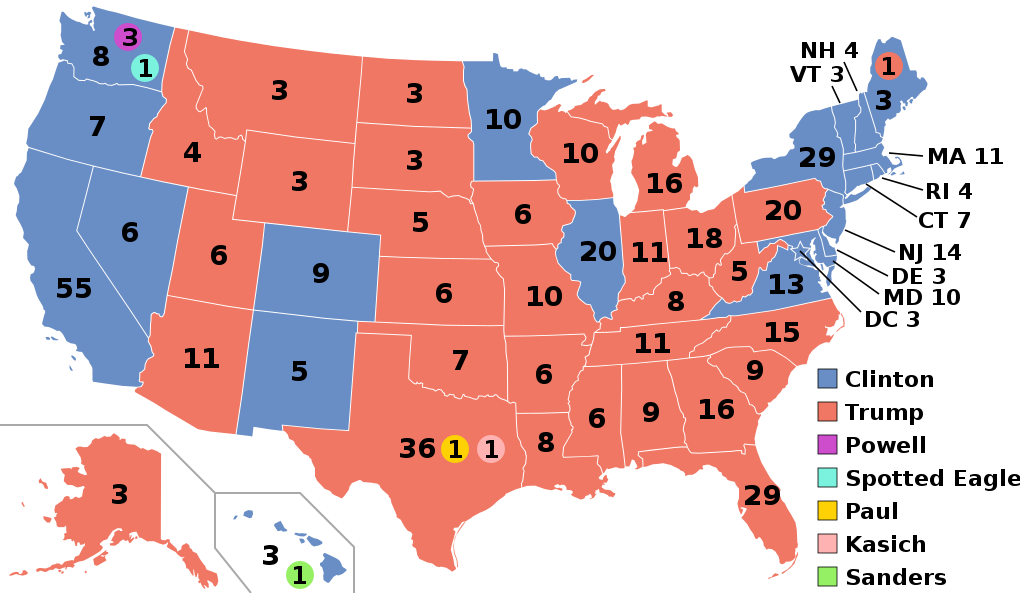Hi Everybody!
Quick Disclaimer: I'm keeping this post mostly non-partisan (at least to the best of my ability). This is about straight up math and statistics.
There have been many calls to scrap the electoral college in light of the fact that Hillary Clinton received a larger share of the popular vote than Donald Trump. Now, had the system been set up from the beginning to be based on a popular vote, campaigning would have likely been a bit different, so the results could have potentially changed as well. But it's interesting to look at 2 different scenarios about the election regarding a potential electoral college change:
1) No Electoral College
This one is fairly easy. Clinton won the popular vote, so she would have won the presidency (barring the difference in campaigning as noted above). However, I find it unlikely that the electoral college will ever go away, mostly because it would required a constitutional amendment, and that requires congress to work together AND 38 states to ratify. Since more than 12 states would see their presidential power diminished as a result, it's probably here to stay.
2) Proportional Electoral College
This is where some math comes in. If you look at what would happen if you kept the electoral college in it's current state but assigned electors based on vote share (rather than winner take all), you see different results. If you ignore rounding and assign electors by vote share across each state, you get the following:
Clinton: 256.98 Electoral Votes
Trump: 253.374 Electoral Votes
Other: 27.646 Electoral Votes (I apologize that I didn't break it up by candidate)
As you'll notice, Clinton has a narrow lead of about 3.6 electors. Not unsurprising given how close the popular vote was, but it showcases that in several states where Clinton lost (especially Texas), she actually got a pretty large chunk of the vote share.
If you do a bit of rounding, assigning whole votes to candidates, you get moderately similar numbers but you do end up with some rounding errors. To fix that, I applied proper rounding for all candidates (include 3rd party) and in the 10 states with an outstanding vote I assigned it to the victor of the state. Those results are here:
Clinton: 264 Electoral Votes
Trump: 263 Electoral Votes
Johnson: 9 Electoral Votes
Stein: 1 Electoral Vote (from California)
McMullin: 1 Electoral Vote (from Utah)
You'll notice something from the rounding: the two main parties were helped significantly from it. Their combined total went from 510.3 in the straight calculation to 527 in the rounded one. Third party candidates have a tough time rounding up to 1 electoral vote in most states, even in the split system.
What does this all mean? Well, not a whole lot, but I do want to focus on a few key points: In both cases, no candidate makes it over the 269 threshold. This more accurately reflects the fact that neither major party candidate earned a majority of the votes. Clinton has a plurality, but her share is still in the 48% range.
Also, no matter what the electoral system, third party candidates struggle to stay relevant. They should be the most vocal about getting rid of the electoral college, as it hurts them the most. Johnson received a far larger portion of the vote than his 0 electoral votes indicate.
--
I'd like to close with a few statistics. As of the time of this writing, Clinton has received 63,640,193 votes to Trump's 61,958,044. That translates to 47.8% and 46.6% of the vote, respectively. If you factor in the turnout rate of 58%, Trump received 27% support of eligible voters. Compared to total US population, he received 19.4% support.
Now, we can quibble about how non-voters or non-eligible voters feel. But any way you slice it, Trump did not receive a "majority". And saying that he has a mandate is laughable. When 27% of the eligible voting population votes for you, it's not really a mandate to do anything. Now, Clinton received around 27.7% of the eligible population, so it's not like she fared all that much better, but in my mind that should be a signal that cooperation and reaching across the aisle is more important now than it ever has been. This is a divided country (almost straight down the middle of of voters), and the governing body would do well to reflect that.
There, only one paragraph of ranting. Hooray.
Until next time,
Ryan
Subscribe to:
Post Comments
(
Atom
)


No comments :
Post a Comment